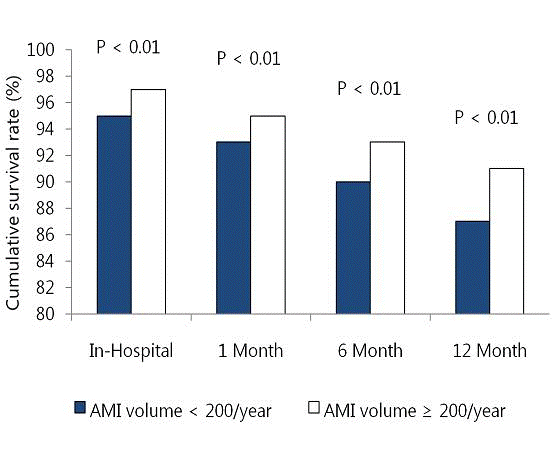| єя«•«ьљƒ : ±Єњђ
|
ЅҐЉцєш»£ - 550042 53 |
| Clinical Outcomes of Primary Percutaneous Coronary Interventions for Acute Myocardial Infarctions in Hospitals With and Without Onsite Cardiac Surgery Backup |
| к≤љнЭђлМАнХЩкµРл≥СмЫР мИЬнЩШкЄ∞лВік≥Љ,¬є к∞ХлПЩ к≤љнЭђлМАл≥СмЫР мИЬнЩШкЄ∞лВік≥Љ,¬≤ м†ДлВ®лМАл≥СмЫР мЛђмЮ•мДЉнД∞,¬≥ лМАнХЬмЛђмЮ•нХЩнЪМ Korean Acute Myocardiac Infarction Registry (KAMIR)вБі |
| мµЬмЭАмЪ©¬є , кєАмЫР¬є , мЮ•мЫРмДЭ¬є, кєАмІДл∞∞¬є ,кєАмИШм§С¬є ,кєАл™Ек≥§¬є ,кєАмЪ∞мЛЭ¬є ,кєАкґМмВЉ¬є ,л∞Хм∞љл≤Ф¬≤, м°∞мІДлІМ,¬≤ кєАмҐЕмІД¬≤, мХИмШБкЈЉ¬≥ , м†Хл™ЕнШЄ,¬≥ KAMIR мЧ∞кµђмЮРвБі |
Background: Due to the development of percutaneous coronary intervention (PCI) technology, the need for coronary bypass graft surgery (CABG) in acute myocardial infarction (AMI) has decreased. We compared the clinical outcomes of patients with AMI undergoing PCI who were treated at hospitals with and without onsite cardiac surgery backup (CSB) in South Korea.
Methods: We analyzed data drawn from the Korea AMI Registry (KAMIR) database. A total of 941 (9.2%) cases that were treated in 11 hospitals without onsite CSB and 9,249 (90.8%) cases that were treated in 40 hospitals with onsite CSB were enrolled. The main study outcome was cardiac mortality. Multiple logistic regression modeling was used to assess the relationship between the presence of onsite CSB and outcome. In subgroup analyses, we defined high volume hospitals as those that treated at least 200 patients with AMI in the emergency department per year.
Results: Age, sex, and several cardiac risk factors were not significantly different between the two groups. There were significant differences in the prevalence of several characteristics, with onsite CSB hospitals having a higher percentage of patients who had diabetes, history of smoking, multi-vessel disease, lower left ventricular ejection fractions, and higher maximal admission NT-proBNP, CK-MB, and TnI levels. There were no significant differences in cumulative survival rates between patient groups (p=0.29). However, high AMI volume hospitals demonstrated superior 0, 1, 6, and 12 month cumulative survival rates.
Conclusions: The results of this study suggest that on-site CSB for PCI provides no survival benefits following primary/rescue PCI in AMI. However, admission to high AMI volume hospitals was associated with reduction in mortality.
|
|
|
Warning: getimagesize(/home/virtual/circulationadmin/renewal/econgress/conference/abstract/img_files/OSKAMIR.gif) [function.getimagesize]: failed to open stream: No such file or directory in /home/virtual/circulationadmin/new/econgress/conference/manage/schedule/view_abstract.php on line 164

|
|





